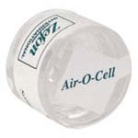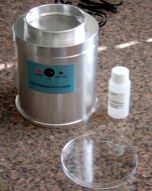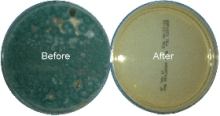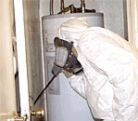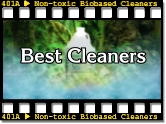
|
|
Services
–
What You Need and What You Can Expect Pro-active Environmental Technologies
to do for You –
|
Services
Part 2 -- Diagnosing the Problem

B. Diagnostics
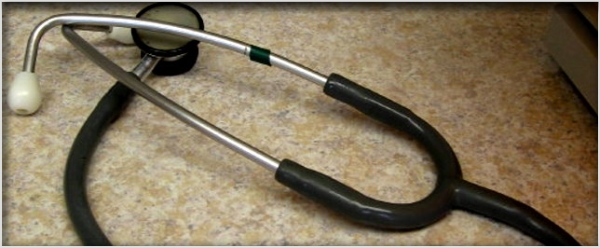 To
aid in the early diagnosis and treatment of
mold and Indoor Air Quality issues, Pro-active
Environmental Technologies offers a
wide range of services including, among others,
To
aid in the early diagnosis and treatment of
mold and Indoor Air Quality issues, Pro-active
Environmental Technologies offers a
wide range of services including, among others,
1. Visual
Mold Inspection
Typically,
Pro-active Environmental Technologies is called
on to perform a mold inspection where mold is
already visible and the client wishes to determine
the cause, specie/s, and extent of the problem,
as well as be advised as to any corrective options.
Visual inspections in this kind of case will
start with the obvious and work back to the
point where the mold appears to have first started
(often, but not always, in a place out of sight),
and will establish the most cost effective treatment
and preventative protocols.
Other
times, clients may suspect that there is a mold
related problem, but there is no mold to be
seen. The reason for the suspicion will likely
be an oppressiveness or “heaviness”
to the air which may or may not be accompanied
by a stale
odor* whose origin cannot be pinpointed.
To the trained technician, the odor trail, if
it exists, can help lead to the questions and
visual clues which will reveal where the mold
is growing.
A
more extreme version of the second scenario
might be that the environs begin to notice some
negative health symptoms. Either at a doctor’s
recommendation (unfortunately all too rare)
or because of their own research, they begin
to understand that what they are experiencing
might well be triggered by the presence of a
mold infestation.
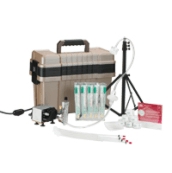
Visual
inspections are made under the trained and experienced
eye of a certified, on-staff, Pro-active Environmental
Technologies mold inspector. It is his or her
knowledge of where to look, for what to look,
what questions to ask of the occupants as to
what they know and have observed, how to correctly
interpret those responses, and the application
of good old hard work and intuition which leads
to a successful inspection. Other inspection
and diagnostic tools are employed wherever warranted
and are described on the following pages (or
their corresponding links).
Mold
is looked for behind wallpaper, paneling, switch
and outlet covers, window and wall hangings,
door and window trims, casings, and baseboards.
Any suspicious discolorations will be targeted
for surface sampling and may also occasion the
taking of one or more air samples.
Depending
upon the nature and severity of the problem,
a written narrative and photographic record
of the inspection is made. The completed report
can be a helpful guide in establishing the nature
and scope of any water and/or mold damage and
the adoption of a step by step program of appropriate
remedial action. It can also be an important
resource when working with insurance claims
and adjusters and directing any contractors
who may need to be engaged.
It
is often wise after any type of corrective action
has been taken to have another visual inspection,
repeating any of the quantifying diagnostics,
to determine the effectiveness of the treatment/repair
actions.
|
|
*At
various times in the mold’s growth stages
mold will manufacture enzymes which are designed
not only to aid in the digestion of whatever
cellulose-based food source upon which it
is feeding but also to be toxic to other molds
which might encroach where a mold colony has
established its specific “turf”.
In fact, it was the observation of this phenomenon
that led to the discovery of the antibiotic
“penicillin”, named after the
mold species Penicillium
which manifested this trait of killing off
other competitive fungi.
It is during the enzyme emitting phase that
the telltale musty or “skanky”
smell is usually detected, and it should be
noted that it is the airborne enzymes which
are most often toxic to people and pets even
when the mold itself may not be. <-- back
|



One
of the valuable reasons for conducting a certified
mold inspection is to rule out mold as a problem
when it does not exist.
Often during the course of a mold inspection
it will be discovered that a dwelling or
building
may manifest discolorations in areas where mold
would logically grow. In
fact, such considerations
may be the reason the client called for the
inspection in the first place.
Depending
upon the need, there are at least two types
of surface sampling which can be performed.
Surface sampling is typically done either with
a swab (which is rubbed on the suspect area
and later rubbed onto a growth medium)
|
|
or
an adhesive laboratory tape which lifts and
collects material similar to the way that
fingerprints are lifted at the scene of a
crime. |
|
|
If
it is more important to know immediately whether
a particular sample is truly mold, a reactive
type of test can return results on the spot within
a matter of minutes.
If
it is more beneficial to identify the particular
specie/s of mold and other items of interest
which can only be revealed under hyper-magnification,
a specimen can be collected and sent to an accredited
lab for verification and quantification with results
being available within several days. This latter
test is most beneficial where toxicity issues need
to be considered.
While
there is a modest additional fee for each such sampling
and the testing which accompanies it, it can be
well worth the peace of mind should the stain or
discoloration turn out not to be mold. And, of course,
there would be considerable savings for not undertaking
any kind of eradication program if it is not actually
warranted.
Wherever
possible, mold inspection is non-destructive and
non-invasive. However, it is sometimes necessary
to get behind or under surface materials in order
to determine the presence or extent of a mold infestation.
|

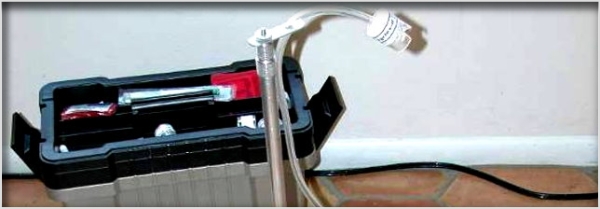
Visible
inspections and surface samplings are powerful
diagnostic tools, but both may fail to reveal
mold and neither are effective at detecting
problems either out of the line of sight or
too small to be seen by the unaided eye. The
absence of visible mold does not always mean
that there is no mold present. It is not uncommon
for there to be high concentrations of mold
and mold spores where there is not even an odor
to give them away. The same is true about
other toxic substances which may be dangerous
though odorless.
In fact, some of the most
commonly disastrous and hazardous mold infestations
occur in unseen areas such as the interiors
of wall cavities, basements, crawl spaces,
attics, behind cupboards and wallpaper, under
eaves, behind water heaters, under sinks,
etc., where no mold is in evidence until tremendous
damage has been done and/or the environs have
been made very ill. To
overcome this obstacle, Pro-active Environmental
Technologies employs one or more forms of air
sampling to reveal the otherwise invisible.
|

Top
of this page --^
<-- Previous
section
Beginning
of this section --^

a. Active
vs. Passive Air Sampling
While
there are many different types
of air samplings which can be performed, there
are really only two basic classes
of air sampling methods — passive
and active.
It is important to be familiar with the differences
in the technologies, because the results between
the two can be significant.

(1) Passive
Air Sampling.
As
the name would suggest, passive air sampling
must depend upon 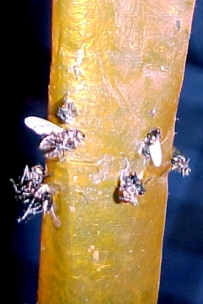 whatever is in the air to
find and hit the target plate. The best analogy
would be to compare it to flypaper which is
hung up in an area with the hope
that flying insects will somehow land
on it. Sometimes it works. But if the air
were full of all manner of flying critters,
how would one know that any of them happening
to land on the sticky paper comprised a truly
representative sampling of ALL the bugs present?
The flypaper at least
uses a component designed to attract insects
to it. The passive collector dish, though
coated with a sticky substance, has no way
to attract microbes, mold, and other pathogens.
If any hit they stick. If they
miss they do not. Does the collection
of "bugs" give an accurate represent ion of
what is present in the air? Who knows? whatever is in the air to
find and hit the target plate. The best analogy
would be to compare it to flypaper which is
hung up in an area with the hope
that flying insects will somehow land
on it. Sometimes it works. But if the air
were full of all manner of flying critters,
how would one know that any of them happening
to land on the sticky paper comprised a truly
representative sampling of ALL the bugs present?
The flypaper at least
uses a component designed to attract insects
to it. The passive collector dish, though
coated with a sticky substance, has no way
to attract microbes, mold, and other pathogens.
If any hit they stick. If they
miss they do not. Does the collection
of "bugs" give an accurate represent ion of
what is present in the air? Who knows?
Virtually
all DIY air sampling kits are passive collectors.
A passive kit merely exposes to the air, for
some period of time (anywhere from fifteen minutes
to several hours), a petri dish containing a
growing medium. Whatever happens to be floating
in the air at the time and finds its way into
the dish is then captured onto the sticky surface
of the growth medium. When the testing period
is over, the dish is capped. Should any viable
mold spores or microbials be part of the entrapped
particulates, the medium will allow the spores
or germs to “hatch” and grow into
colonies over the next several days.
It
is not a bad test for what it does – verify
that at least one viable spore or pathogen was
present at the time and place of the test and
allow for the identification of the colony specie
which developed from the spore or microbe.
What
a passive test does not do is provide enough
data to tell whether the presence of mold spores
or microbes was a random event or allow
for a credible prediction as to the likelihood
that other such colonies might be growing in
that part of the building’s air space.
Nor does it take into consideration the possibility
that other species and contaminates might be
present in the area which did not make it into
the test dish. All such a test would show is
that mold spores or other microbials happened
to be near the dish and make their way into
it the day the dish was exposed.
So, while the passive sampler may not tell us all we need to know, we
can deduce this. If a passive sampler is used and there is a resultant
significant growth of mold and/or bacteria in the sampler dish, there
are definitely problems with the indoor air quality where the sample
was taken which need to be addressed ASAP.
|

Top
of this page --^
<-- Previous
section
Beginning
of this section --^

Active
air sampling is more like the butterfly net
approach, in that sampling is not determined
by what flies in of its own accord. With
active sampling a sufficient volume of air
is forced to pass over the sticky collection
media which will retain whatever was flying
in or being carried by the ambient air. When
completed, the results are tabulated. By calibrating
the volume of air made to pass over the plate
for a specific length of time results will
represent a fairly accurate sampling of what
and how much is in the air space. All
air samples taken by Pro-active Environmental
Technologies are of the active
class, a far more scientifically accurate
means of sampling and verification.
Depending
upon the kinds of data needed for assessment,
there are two kinds of active sampling which
can be used, and there are commonalities between
them. sticky collection
media which will retain whatever was flying
in or being carried by the ambient air. When
completed, the results are tabulated. By calibrating
the volume of air made to pass over the plate
for a specific length of time results will
represent a fairly accurate sampling of what
and how much is in the air space. All
air samples taken by Pro-active Environmental
Technologies are of the active
class, a far more scientifically accurate
means of sampling and verification.
Depending
upon the kinds of data needed for assessment,
there are two kinds of active sampling which
can be used, and there are commonalities between
them.
|
|
|
|
|
(a) |
Both
types should be used with at least one sample taken
from outside the building to serve as a control in
establishing the relative difference between the outdoor
and indoor air quality. Depending upon locale, it
may be best to have one outdoor sample from each outside
elevation of the house as topography, drainage, and
landscaping can alter the quality of the ambient air.
(For instance, environments with a lot of plant overgrowth
around a building may show elevated mold counts, because
the amount of shade, retained moisture, and presence
of decayed or decaying vegetation will harbor mold.)
|
|
|
|
|
(b) |
Both work with a sticky type of collection medium
which is bombarded by a measured amount of air forced
to it by a specialized air pump.
|
|
|
|
|
(c) |
Both
work with calibrated amounts of air. Calibrations
of the pump’s consistency are made and checked
to an outside standard to assure that flow rates across
a collection medium happen at a specific force and
encompass a set volume of air. This is typically 15
cubic feet of air per minute – “15 CFM”
– over a set period of time (usually five minutes),
for a total volume of 75 cubic feet of air sampled.
|
|
|
|
|
(d) |
Both
types of collection devices are sealed and a chain
of custody log established when the collection time
has elapsed. Then, depending upon the type of results
required, the collectors are either observed over
time for growth or sent to an accredited lab for processing
and analysis.
|
|
|
|
|
(e) |
Both
are designed to insure that the sampling represents
a standardized cross section of the available air
in a given air space and not just a random pocket
of ambient air and its contaminant load.
|

Top
of this page --^
<-- Previous
section
Beginning
of this section --^

b. Two
Types of Active Air Samplers
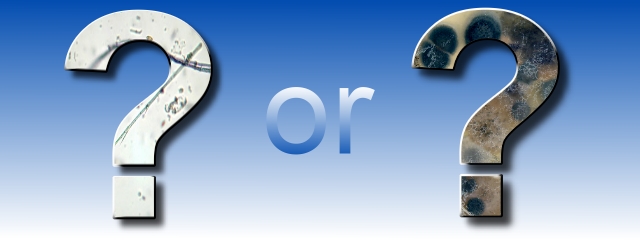
|
In
order to know specifics regarding indoor air quality
and how to address any negative issues, there are
two types of active air samplers. One is not
necessarily better than the other. Both are
important, but both are designed to collect a
particular kind of data -- one static and the other
dynamic.
|
|
|
|
(1) |
Total
Particulates.
The first type of air sample employs a specially designed
collection cassette with a sticky target plate which
will grab and hold whatever is in the air being forced
over it.
|
|
|
Under
microscopic magnification, this
allows for
the enumeration and identification of every little
bit, piece, and speck of whatever was in the air
that smacked onto the target plate — usually
an unsavory mixture of things like mold, mold spores,
dust, dust mites, skin cells, pollen, insect parts,
pet dander, feathers and feather bits, ash, soot,
sand, feces particles, and all manner of other unthinkable
things which people are taking into their airways.
|
|
stachybotrys
|

skin cells |

dust mite |

pine pollen |
|
|
|
|
Extrapolations
from this test are used to calibrate the overall cleanliness
of the air known as total particulate
count. It is very helpful in comparing
indoor air quality with that of the outdoors. |
|
|
|
|
|
|
|
|
|
(2) |
Viable
Colony Count.
The second type of air sample is similar to the passive
sampler, in that it also uses a petri dish containing
a growth medium. But in the active instance, the flow
of air is calculated and precise and therefore provides
accurate representation of the overall quality of
air as it relates to the presence of mold spores and
microbials capable of creating a problem. |
|
|
|
|
|
Depending
upon the purpose of the test, once the collection
is made, one of two protocols is followed. If relative
comparisons alone is the aim in order to establish
before and
after
conditions related to air treatment, all samples are
observed and photographed at specific timed intervals
such as 24, 48, 72, 96, 120 hours, etc. Because
some species of mold and other contaminates are slower
growing than others, this allows for tracking the
viability, virulence, growth rate, and varieties contained
within the samplings. Where there may be litigation
involved and more specific information is required,
all the test samples are kept below a certain temperature
until they reach an accredited lab so that the number
of colonies any mold spores or microbes incubate can
be timed and quantified.
|
|
|
The
results are identified by specie and measured in CFU’s
or “Colony Forming Units”, a number which
indicates the level of mold infestation or microbial
danger and helps project what the potentials for a
disastrous infestation would be if conditions allowed
for maximum outbreak of mold or pathogens based upon
numbers of spores/microbes present. It also is an
indicator of the relative related health risks
to the environs in a building. |
|
|
|
|
Variations
of both of these active types of devices can be
used to sample specific areas of carpets or drapes
and even collect samples from inside wall cavities
with minimal invasion or damage to the plaster or
drywall.
When
either the content or the volume of the contaminants
within the specimens exceeds what is known to be
safe, effective corrective measures can be taken.
Before
and after samplings can be used to compare the efficacies
of any mold or microbial eradication regimens
undertaken. As one would expect, there are additional
costs for each sample and lab analysis performed.
Use
of air sampling puts to the lie the misconception
in our popular culture that mold and microbials only
grow in dim and unkempt areas of buildings and in
the homes of the less advantaged. To the contrary,
properly conducted air sampling has repeatedly proven
that many upscale buildings and residences routinely
fall prey to both types of infestations – even
where housekeeping is almost religiously immaculate.
It is the one definitive way to find out if mold or
pathogenic infestations do or do not exist in an occupied
environment.
|

Top
of this page --^
<-- Previous
section
Beginning
of this section --^

4. Minimally
Invasive Boroscope® Inspection

In
the past, just looking for mold or microbials could
be an expensive and dangerous proposition. Because
either -- and especially mold -- can lurk in so many
hard to reach places, conventional practice was to
observe or suspect a problem in a building and, beginning
there, to start smashing drywall (politely called
“demolition work”) to see to what extent
it had spread. It would be similar to asking a doctor
to find and diagnose an internal illness when his
only tool was a scalpel or bone saw. The problem is
exacerbated when the hammer blows or saw cuts actually
strike near a mold colony and scatter billions of
eager spores or other contaminates throughout the
living space.
Fortunately,
Pro-active Environmental Technologies
employs instrumentation which makes use of fiber optics
in peering behind and into places otherwise inaccessible
to determine the presence of a mold intrusion.
Any
penetrations in the “skin” of a wall,
whether interior or exterior, to allow observation
within a wall’s cavities can be done with judicious
precision, allowing for minimally invasive inspection
of a structure.
It
is also helpful in examining behind large pieces of
furniture — where mold might have taken root
up against a wall or another surface — without
having to hire movers to allow the inspection to take
place.
Fiber optics allow the inspector to examine the walls
and cabinets behind and under sinks, track feeder
plumbing behind walls, inspect behind water heaters,
and look in all the places moisture likes to intrude
and collect which do not always present themselves
to the unaided eye.
|

Top
of this page --^
<-- Previous
section
Beginning
of this section --^

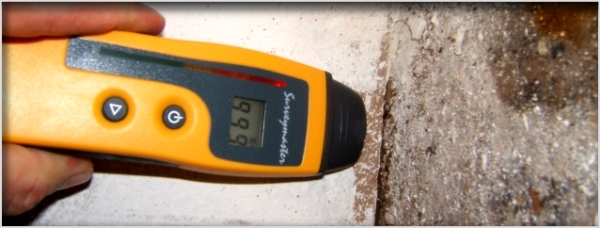
Temperature
and relative humidity differentials are valuable
clues when trying to pinpoint a suspected problem
such as mold which may not be readily visible. Pro-active
Environmental Technologies makes use of non-destructive
moisture detectors and infrared temperature and
relative humidity devices to aid in finding hidden
areas where mold may be growing or in tracking a
water intrusion to its source.
These
instruments allow the inspector to find moisture
behind walls and baseboards, in saturated construction
members, and even in large amounts of insulation
— anywhere that water or elevated moisture
can be a breeding ground for destructive and deadly
species of mold or other pathogens. They can also
indicate where air conditioning ducts are leaking,
causing cold spots on the interiors of walls which
then condense moisture and harbor mold.
While
mold sanitization can penetrate wall cavities and
kill mold in such places even if undetected, it
is the presence of moisture
which must be found and corrected in order to keep
the mold from coming back. Therefore, the Pro-active
Environmental Technologies inspector will use all
the tools available to find the mold’s source
and underlying cause/s so that the present problem
can be corrected and future ones avoided.
|
 

All materials not supplied by manufacturers or others are
Copyright
2005 - 2014 -- breathe-easier.com
-- All Rights Reserved
|
 |
NEW!

Check
out the videos


A. The
Need for IAQ Services
It's a much-needed checkup for your building and the air you are breathing.


1. The Need for Mold Services
There's more than the appearance or lack of visible mold at stake. It could be your health and life!
go>>


2. The Need for General and Specific IAQ Evaluation Services
What you are breathing is either helping you stay healthy or making you sick.
go>>


B. Diagnostics -- Getting to the Source and Extent of the Problem
go>>


1. Visual
Mold Inspection
Start with the obvious. If you can see it, it must be taken away.


2. Surface Sampling
Not every discoloration is mold. Better know the difference. Can you tell?

3. Air Sampling
It's what you can't see in the air but are still breathing that can be the most harmful. Here's how to check it out.

a. Active
vs. Passive Air Sampling
Two ways to find out what's in the air and which is best.


(1) Passive
Air Sampling
Waiting for the contaminates to decide to hit the target on their own. Nice when it works, but how often is that?


(2) Active
Air Sampling
It's about going after what is in the air so you really know what you are dealing with.


b. Two
Types of Active Air Samplers
Specific ways to target specific contaminates.


(1) Total
Particulates
Getting a count of everything that wants to go into your airways.


(2) Viable
Colony Count
Besides being just downright obnoxious, how likely is what you are breathing going to cause an infestation or an infection?


4. Minimally
Invasive Boroscope® Inspection
This is a chance to see what is going on inside wall cavities and other out-of-sight places.


5. Moisture
Detection
Mold and pathogens, like us, need moisture. Are we giving them an opportunity to thrive?



C. Correctives
Knowing what is wrong is only part of the battle. Now let's explore our options for fixing the problem.


D. Abatement
When we talk about getting rid of mold, what are we really talking about?


1. Notice.
Venture into the Mold Zone only with extreme care and protective measures.


2. The
Options
Is there only one way to proceed, and if there are alternatives, what are they and how effective can they be?


a. Standard
("Conventional") Protocol
-- Ox cart technology in a space age world.


(1) The
Procedures of Conventional Protocol
If we are going to use yesterday's technology, let's at least do it the right way.


(2) The
Prerequisites for Conventional Protocol
There are certain things that must be done FIRST before going after mold in the conventional way.


b. Superior
Protocol --
Introduction to "BATT" (Best Available Today's Technology) -- For Mold, Odor, and Microbial Abatement.


E. Mold
Prevention and Indoor Air Quality Programs
It's one thing to get rid of an existing problem, but do we want a repeat appearance?
|
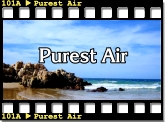








































































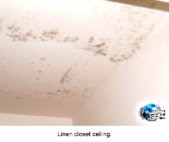


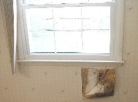

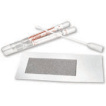
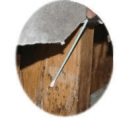
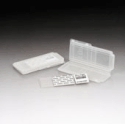
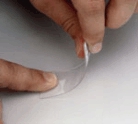
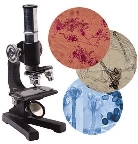

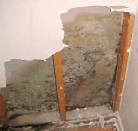
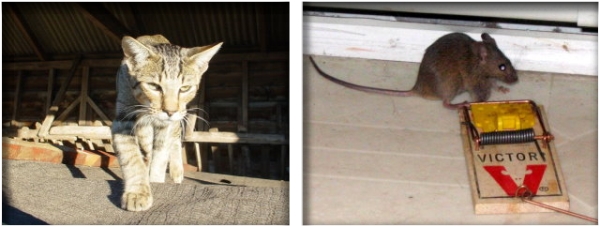
 whatever is in the air to
find and hit the target plate. The best analogy
would be to compare it to flypaper which is
hung up in an area with the hope
that flying insects will somehow land
on it. Sometimes it works. But if the air
were full of all manner of flying critters,
how would one know that any of them happening
to land on the sticky paper comprised a truly
representative sampling of ALL the bugs present?
The flypaper at least
uses a component designed to attract insects
to it. The passive collector dish, though
coated with a sticky substance, has no way
to attract microbes, mold, and other pathogens.
If any hit they stick. If they
miss they do not. Does the collection
of "bugs" give an accurate represent ion of
what is present in the air? Who knows?
whatever is in the air to
find and hit the target plate. The best analogy
would be to compare it to flypaper which is
hung up in an area with the hope
that flying insects will somehow land
on it. Sometimes it works. But if the air
were full of all manner of flying critters,
how would one know that any of them happening
to land on the sticky paper comprised a truly
representative sampling of ALL the bugs present?
The flypaper at least
uses a component designed to attract insects
to it. The passive collector dish, though
coated with a sticky substance, has no way
to attract microbes, mold, and other pathogens.
If any hit they stick. If they
miss they do not. Does the collection
of "bugs" give an accurate represent ion of
what is present in the air? Who knows? 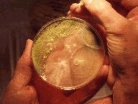
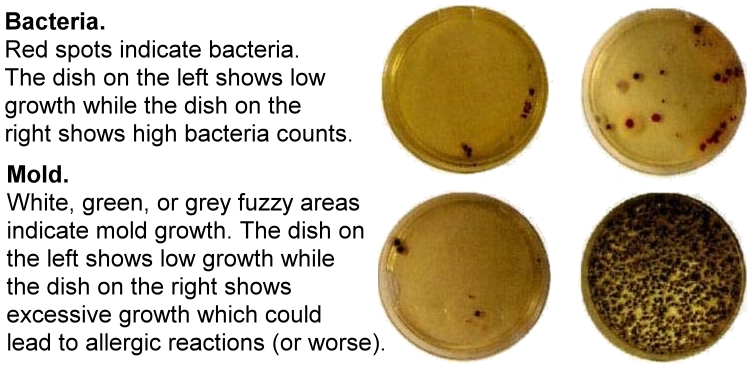
 sticky collection
media which will retain whatever was flying
in or being carried by the ambient air. When
completed, the results are tabulated. By calibrating
the volume of air made to pass over the plate
for a specific length of time results will
represent a fairly accurate sampling of what
and how much is in the air space. All
air samples taken by Pro-active Environmental
Technologies are of the
sticky collection
media which will retain whatever was flying
in or being carried by the ambient air. When
completed, the results are tabulated. By calibrating
the volume of air made to pass over the plate
for a specific length of time results will
represent a fairly accurate sampling of what
and how much is in the air space. All
air samples taken by Pro-active Environmental
Technologies are of the 